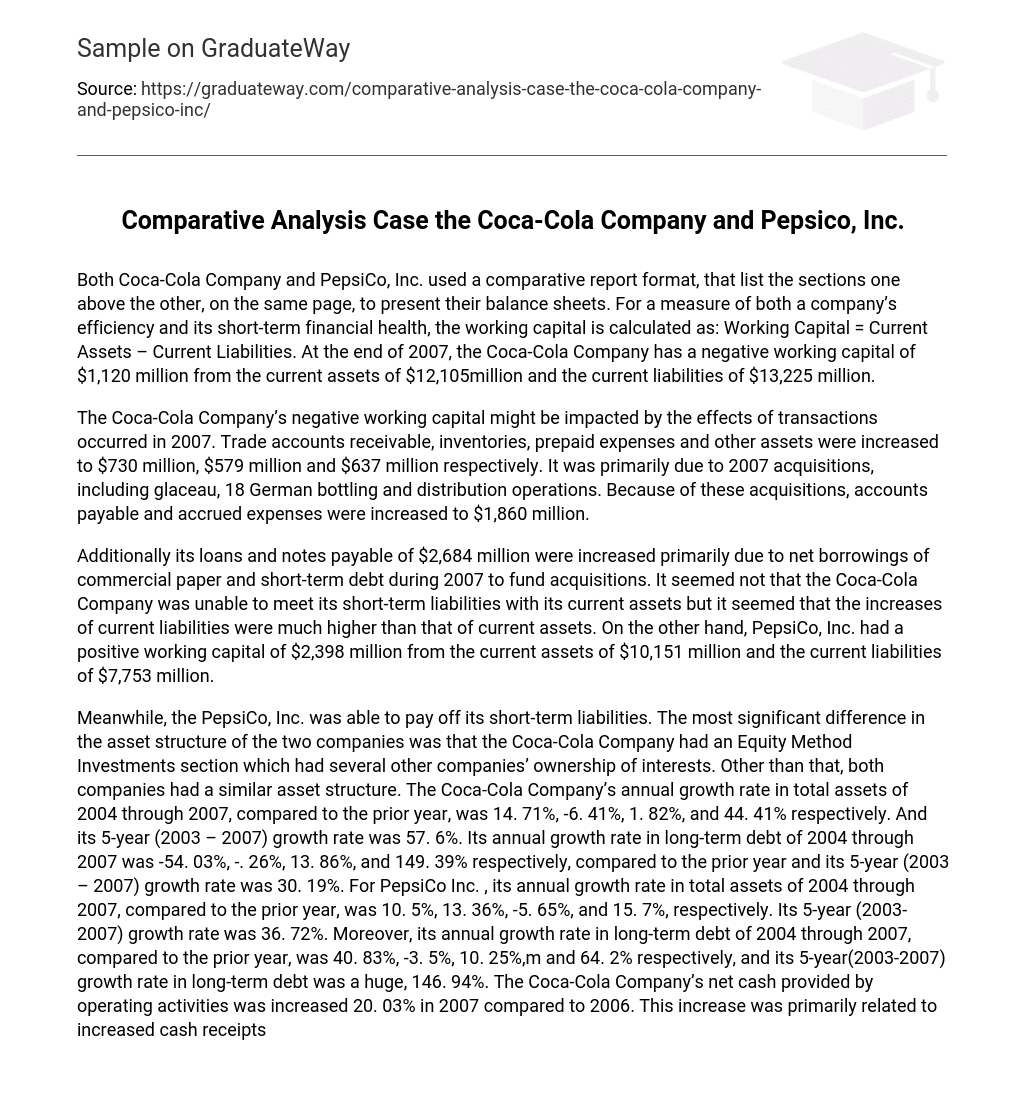Both Coca-Cola Company and PepsiCo, Inc. used a comparative report format, that list the sections one above the other, on the same page, to present their balance sheets. For a measure of both a company’s efficiency and its short-term financial health, the working capital is calculated as: Working Capital = Current Assets – Current Liabilities. At the end of 2007, the Coca-Cola Company has a negative working capital of $1,120 million from the current assets of $12,105million and the current liabilities of $13,225 million.
The Coca-Cola Company’s negative working capital might be impacted by the effects of transactions occurred in 2007. Trade accounts receivable, inventories, prepaid expenses and other assets were increased to $730 million, $579 million and $637 million respectively. It was primarily due to 2007 acquisitions, including glaceau, 18 German bottling and distribution operations. Because of these acquisitions, accounts payable and accrued expenses were increased to $1,860 million.
Additionally its loans and notes payable of $2,684 million were increased primarily due to net borrowings of commercial paper and short-term debt during 2007 to fund acquisitions. It seemed not that the Coca-Cola Company was unable to meet its short-term liabilities with its current assets but it seemed that the increases of current liabilities were much higher than that of current assets. On the other hand, PepsiCo, Inc. had a positive working capital of $2,398 million from the current assets of $10,151 million and the current liabilities of $7,753 million.
Meanwhile, the PepsiCo, Inc. was able to pay off its short-term liabilities. The most significant difference in the asset structure of the two companies was that the Coca-Cola Company had an Equity Method Investments section which had several other companies’ ownership of interests. Other than that, both companies had a similar asset structure. The Coca-Cola Company’s annual growth rate in total assets of 2004 through 2007, compared to the prior year, was 14. 71%, -6. 41%, 1. 82%, and 44. 41% respectively. And its 5-year (2003 – 2007) growth rate was 57. 6%. Its annual growth rate in long-term debt of 2004 through 2007 was -54. 03%, -. 26%, 13. 86%, and 149. 39% respectively, compared to the prior year and its 5-year (2003 – 2007) growth rate was 30. 19%. For PepsiCo Inc. , its annual growth rate in total assets of 2004 through 2007, compared to the prior year, was 10. 5%, 13. 36%, -5. 65%, and 15. 7%, respectively. Its 5-year (2003-2007) growth rate was 36. 72%. Moreover, its annual growth rate in long-term debt of 2004 through 2007, compared to the prior year, was 40. 83%, -3. 5%, 10. 25%,m and 64. 2% respectively, and its 5-year(2003-2007) growth rate in long-term debt was a huge, 146. 94%. The Coca-Cola Company’s net cash provided by operating activities was increased 20. 03% in 2007 compared to 2006. This increase was primarily related to increased cash receipts from customers in 2007, which was driven by a 20% rise in net operating revenues. However, cash flows from operating activities decreased 7. 26% in 2006 compared to 2005. This decrease was primarily the result of payments in 2006 of marketing accruals recorded in 2005 related to increased marketing and innovation activities.
And increased tax payments made in the first quarter of 2006 related to the 2005 repatriation of foreign earnings under the Jobs Creation Act. The PepsiCo’s operations provided $6. 9 billion of cash, in 2007, compared to %6. 1 billion in the prior year, and $5,8 billion in 2005. Its operating cash flows in 2006 also reflect a tax payment of $420 million related to PepsiCo’s repatriation of international cash in connection with the AJCA (American Jobs Creation Act).





